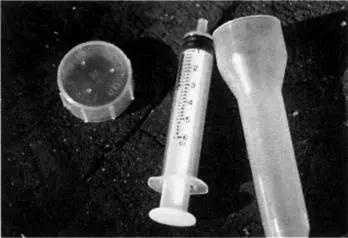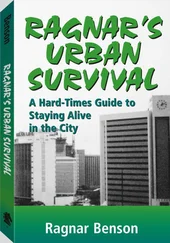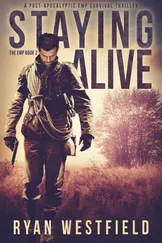Ragnar Benson - Ragnar's Urban Survival - A Hard-Times Guide to Staying Alive in the City
Здесь есть возможность читать онлайн «Ragnar Benson - Ragnar's Urban Survival - A Hard-Times Guide to Staying Alive in the City» весь текст электронной книги совершенно бесплатно (целиком полную версию без сокращений). В некоторых случаях можно слушать аудио, скачать через торрент в формате fb2 и присутствует краткое содержание. Год выпуска: 2009, ISBN: 2009, Жанр: Старинная литература, на английском языке. Описание произведения, (предисловие) а так же отзывы посетителей доступны на портале библиотеки ЛибКат.
- Название:Ragnar's Urban Survival: A Hard-Times Guide to Staying Alive in the City
- Автор:
- Жанр:
- Год:2009
- ISBN:1581600593
- Рейтинг книги:5 / 5. Голосов: 1
-
Избранное:Добавить в избранное
- Отзывы:
-
Ваша оценка:
- 100
- 1
- 2
- 3
- 4
- 5
Ragnar's Urban Survival: A Hard-Times Guide to Staying Alive in the City: краткое содержание, описание и аннотация
Предлагаем к чтению аннотацию, описание, краткое содержание или предисловие (зависит от того, что написал сам автор книги «Ragnar's Urban Survival: A Hard-Times Guide to Staying Alive in the City»). Если вы не нашли необходимую информацию о книге — напишите в комментариях, мы постараемся отыскать её.
Ragnar's Urban Survival: A Hard-Times Guide to Staying Alive in the City — читать онлайн бесплатно полную книгу (весь текст) целиком
Ниже представлен текст книги, разбитый по страницам. Система сохранения места последней прочитанной страницы, позволяет с удобством читать онлайн бесплатно книгу «Ragnar's Urban Survival: A Hard-Times Guide to Staying Alive in the City», без необходимости каждый раз заново искать на чём Вы остановились. Поставьте закладку, и сможете в любой момент перейти на страницу, на которой закончили чтение.
Интервал:
Закладка:
Better in this case to worry about ourselves, allowing whatever foolishness is being sown to establish itself at harvest.
Chapter 12

Survival Nursing
Nursing in a survival context seldom receives much interest and attention. Pity, since this single activity can save or-as more frequently occurs-lose significant numbers of lives. Especially when undertaken by uninformed, unprepared survivors.
Nursing in any form is defined as the act of providing skilled, appropriate, long-term sheltering care leading to successful convalescence and recovery from accidents, sickness, or wounds. Nursing for city survivors is especially critical because initial care provided by some persons who are less than skilled and trained may be borderline at best. In an emergency, we may be sewed up by nurses, dentists, pharmacists, farmers, veterinarians, dental assistants, chiropractors, and even at times common private citizens.
That all of these people are extremely well-intentioned and correspondingly anxious to do the right thing is little consolation. In a survival situation, even medical doctors will be constrained by a lack of proper drugs, instruments, and facilities. Placing an untrained or borderline amateur in these circumstances is definitely not ideal, but will be necessary if any lives are to be saved.
City survivors are also faced with the fact that because of the large number of people they may encounter in cities, they will also come across some who req.Jire long-term nursing care. We should understand that because of the nature of our existence, we will be called on to nurse many friends, family members, and close acquaintances found around us in cities who have also received less than ideal or even adequate initial care.
Standards of cleanliness were still primitive by today's standards, but during our own Civil War, it was received truth that patients quickly evacuated from central hospitals into private homes had the best chance of survival. Often it was not the shotoff legs or shattered ribs that killed patients, but rather horrible, raging, epidemic infections. Hospitals and central receiving areas for the wounded were notorious pest houses, which was intensified by the fact that no one in the medical profession knew what caused infections. In that regard alone, modern city survivors are at great advantage.
Patients allowed to remain even a few days at these central medical. areas were virtually 100-percent certain of acquiring an infectious disease for which there was little hope. Two lines on the graph crossed creating this horror: the native strength of wounded men lying in bed ebbed while infections spread and raged.
Some knowledgeable folks still maintain that even today there is great risk of infection in our modern hospitals. Perhaps this is an overstatement, but only because rigorous measures are taken to minimize infectious conditions in hospitals. To a certain extent these measures are also available to city survivors.
Along with modern miracle disinfectants for both the patient and the room, modern hospitals have crews that do little but scrub, scrub, and scrub al.. day long. Even within the past 10 or 12 years, remarkable new technologies have come on the scene that give disease-causing germs less chance to hide and prosper. These include disease abatement, construction techniques, new and remarkable construction materials, special paints, sealers, and finishes that really keep dirt, filth, and infection in check and, of course, disinfectants that-by Civil War standards-are nothing short of miraculous.
One of the keys to survival nursing is getting your friend or loved one out of any central medical treatment area into a nursing retreat as quickly as possible. Then it is vital that the retreat not become a hospital. That is, treat this one patient or, at most a small batch of two or three patients, and then quit. Most nurses recommend waiting 3 or 4 months after the retreat is cleaned and disinfected before starting with the next batch of patients! The overlap of patients quickly leads to great concentrations of uncontrollable disease and infection.

Antiseptics are miraculous in their application even when compared to materials available just 20 years ago.
City survivors have some dramatic modern disinfectants available to them. For patients themselves, we have Betadine, gentle iodine and hydrogen peroxide, among others. These materials are generally used to clean and treat personal wounds, but other especially good disinfectant materials useful on floors, walls, and ceilings are available from veterinary or farm supply stores. These are Bioguard X-185 containing 30 percent cresylic acid, Roccal D, 1 Stroke Environ, and even raw formaldehyde.
Because disinfecting barns and pig stalls is much tougher than disinfecting most bedrooms or tents, these materials are high powered, highly concentrated, state of the art, and extremely effective. They are certainly as good as anything in local hospitals.
Flies and lice may be a problem for survivors left too long in central receiving areas or in dirty, filthy retreats used by numbers of different people. At Stalingrad lice were epidemic among German soldiers. Lice just show up and prosper in those sorts of conditions. Again, some effective materials are available over the counter from your friendly vet supply store. These will give you the upper hand over flies and lice. Look for treatments with high concentrations of lindane and pyrethrins. These materials may also be used to help sterilize bedding, clothes, draperies, rugs, and tent bottoms. As a practical matter, survival nursing quarters should be on stone, cement, or finished wood. Avoid rugs or other porous materials.

Commonly disposable items may be sterilized and reused in a survival situation.
Modern hospitals use mostly throwaway plastic kits for their procedures. Specialized kits, some of which are breathtakingly expensive, exist for virtually everything. They range from simple little packets designed to facilitate intravenous medications to great, elaborate affairs required for complete laparoscopic surgery. We won't have these pre-sterilized kits. Even if we did we couldn't afford to throw them out after just one use. Reportedly, some of these kits are presently recycled to some extent, but one wonders.
Survival nurses will have to make provisions to sterilize all of their instruments that will be used repeatedly. Boil for at least 20 minutes all gear, including needles, hemostats, scalpels, and the like. In a survival context most of these tools are irreplaceable. All must be cleaned up and resterilized. In cases where boiling vigorously in a shallow, open container will either ruin the apparatus or may not clean and sterilize it, strong disinfectants can be used as a wash. Many times we do both. To an extent, infections are treatable with modern veterinary-grade antibiotics, but in a survival context these materials will be scarce. Why ask for additional trouble?
Likely we won't think of it now, but provision should be made to thoroughly incinerate bandages, cotton, infected clothes, bedding, and other miscellaneous contaminated items. Thorough burning will consume even more of our scarce energy supplies and could conceivably compromise our position, but it may be necessary to limit the chances of spreading disease.
Читать дальшеИнтервал:
Закладка:
Похожие книги на «Ragnar's Urban Survival: A Hard-Times Guide to Staying Alive in the City»
Представляем Вашему вниманию похожие книги на «Ragnar's Urban Survival: A Hard-Times Guide to Staying Alive in the City» списком для выбора. Мы отобрали схожую по названию и смыслу литературу в надежде предоставить читателям больше вариантов отыскать новые, интересные, ещё непрочитанные произведения.
Обсуждение, отзывы о книге «Ragnar's Urban Survival: A Hard-Times Guide to Staying Alive in the City» и просто собственные мнения читателей. Оставьте ваши комментарии, напишите, что Вы думаете о произведении, его смысле или главных героях. Укажите что конкретно понравилось, а что нет, и почему Вы так считаете.











